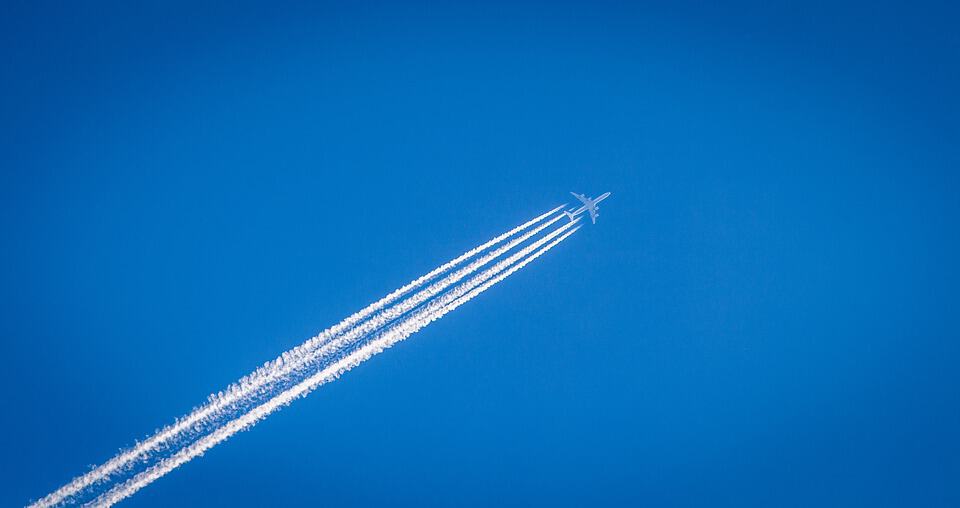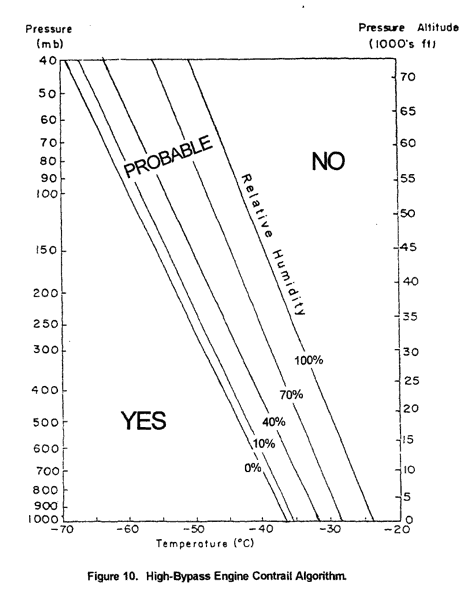
Contrails are the visible reminder that on a daily basis numerous commercial and private flights cross the skies across the world. But some aircraft leave these white trails behind them and others do not, even when seemingly in the same general part of the sky. When aircraft do leave contrails behind, some contrails last hours and other contrails last mere seconds or minutes. Why do some airplanes leave contrails and some don’t?
Contrails are formed from extremely cold air mixing with hot exhaust gasses. Contrail formation is most likely at altitudes at or above 35,000 feet and at temperatures below -58°F (-50°C), therefore contrails are mostly formed by jets. Turboprop and piston engine airplanes generally fly in lower, warmer air where contrails are less likely to form.
Combustion, in its purest form, creates two compounds: water (H2O) and carbon dioxide (CO2). These gases are expelled from the engine at well above 1000°F (540°C), meaning the water vapor is entirely in the form of steam.
At the typical cruise altitudes of jet powered aircraft the outside air temperature is routinely -50°F (-45°C) or colder, this temperature difference nearly instantly condenses the water vapor into ice crystals, forming clouds. The phenomenon is similar to that of seeing your breath on a cold winter morning, but at a far larger scale.
Why Do Some Airplanes Leave Contrails and Some Don’t
The atmospheric conditions required for the formation of contrails are cold temperatures and low to moderate humidity. This combination of conditions occurs regularly at the cruising altitude of most turbofan and turbojet powered aircraft. Airliners, business jets, and military aircraft all use turbofan and turbojet engines to cruise at these high altitudes where contrail formation is most likely to occur.
Turbofans and turbojets directly expel their exhaust to the atmosphere, providing the mixture of carbon dioxide, water vapor and trace soot particles little time to cool. In contrast, turboprop powered aircraft that use jet engines to drive a propeller typically fly at lower altitudes; in addition they extract power from the exhaust gases to drive the propeller, and those gases pass through exhaust stacks to the outside of the aircraft.
This combination of power extraction, exhaust stacks, lower altitudes and warmer temperatures reduces the exhaust gas to outside air temperature gradient sufficiently to generally reduce the likelihood that contrails will form.
Modern piston engine powered aircraft are largely incapable of reaching the altitudes and thus temperatures where contrail formation is possible. Additionally, the exhaust manifolds used on these engines allow the exhaust gasses to cool substantially prior to interacting with the atmosphere.
However, it is worth noting that the massive radial engines that powered the bombers of WWII and the early Cold War did in fact create contrails. The incredible power output of these engines and allowed these aircraft to cruise at altitudes where the temperatures were sufficiently cold to produce contrails.
What Conditions Make Contrail Formation Likely?
Most importantly, extremely cold air mixing with hot exhaust gasses leads to the formation of contrails. Rapid cooling of the water vapor from combustion temperature to ambient temperature forces ice crystals to form, creating the clouds that are referred to as contrails.
The second critical atmospheric condition is low relative humidity. Without low humidity present, water vapor in the exhaust gasses does not form into ice crystals that linger long enough to create a noticeable contrail.
High pressure is the third ingredient to forming persistent contrails. High atmospheric pressure is generally associated with colder temperatures at high altitude, resulting in larger temperature gradients from the exhaust to the surrounding air, thus resulting in the rapid cooling of water vapor to form ice crystals.
Engine design factors may also contribute to contrail formation. The exhaust temperature of an engine is dependent of a range of factors, but generally speaking newer, more efficient jet engines burn less fuel at hotter temperatures.
In order to achieve the same or greater thrust output, these newer engines pass larger amounts of air around the combustion section (this is called bypass air, and the relationship between bypass air and burned air is expressed as bypass ratio), leading to better mixing of the bypass and combustion air, encouraging the formation of contrails.
Studies of bypass ratio on contrail formation suggest that larger bypass ratios (less air burned, more air diverted around the combustion section) results in more frequent contrail production.
Why Do Some Contrails Take So Long to Disappear?
The persistence of contrails is largely dependent on atmospheric conditions. While too much humidity prevents the formation of contrails altogether, too little humidity results in contrails that sublimate from ice back to vapor quickly.
Temperature also affects this relationship, with research indicating that an optimum temperature for persistent contrails exists, decreasing with increasing altitude.
Additionally the presence of particulate matter in the engine exhaust may allow contrails to persist for longer periods of time by providing condensation nuclei for ice crystals to form around. These condensation nuclei allow the ice crystals to grow prior to sublimating back to vapor, yielding longer lasting contrails.
Older jet engines and turbojet engines tend to create exhaust plumes with more of these particulates present resulting in potentially longer lived contrails.
Is It Possible to Predict the Formation of Contrails?
Contrail formation has been studied and is regularly forecast, particularly by military organizations that seek to avoid visual detection of their aircraft. The Appleman Contrail Forecast chart has been in use since 1953 to predict contrail formation.
Further study by the United States Air Force, concluded in 1993 suggests that contrail formation is most likely at altitudes at or above 35,000 feet and at temperatures below -58°F (-50°C). This research conducted by the USAF resulted in new prediction tools for contrails.
The USAF research confirmed that decreasing temperature and humidity combined with increasing altitude improved the likelihood of contrail formation.
For lines of constant relative humidity, contrail formation occurs at lower temperatures and higher altitudes. Additionally, increased bypass ratio engines similar to those used on airliners and business aircraft possessed a wider contrail production envelope, with the same relationship between atmospheric conditions remaining across engine types. This further explains why some airplanes produce contrails more frequently than others.

Figure 1: High Bypass Engine Contrail Algorithm – New Techniques for Contrail Forecasting, Capt. Jeffrey L. Peters, Air Weather Service, Scott Air Force Base – 1993
What Is the Black Exhaust Left By Some Aircraft During Takeoff?
These black plumes are primarily soot from partially burned fuel, and are distinct from contrails. For older engine designs in particular, to keep the internal engine components cool during takeoff and climb, excess fuel is used during the takeoff phase of flight, leading to an overly rich fuel mixture. This rich fuel mixture does not burn as completely or efficiently, resulting in soot forming in the exhaust plume.
This soot phenomenon is similar to that seen coming from large tractor trailer trucks. Engine manufacturers optimize the internal components of engines for the high airspeeds, low ambient temperatures and low air densities aircraft encounter during cruise flight.
Older turbofan engines and turbojet aircraft are particularly susceptible to this kind of soot production. Classic examples of this type of engine behavior are the B-52 bomber and MD-80 airliner.
Why Are Contrails So Common?
Because contrails are essentially man-made clouds, the more common air travel becomes, and the more efficient jet engines become, contrails will also become more numerous and potentially last for longer periods of time.
The primary sources of contrails are consistently jet powered aircraft, particularly those with multiple large high bypass ratio engines like those common on modern airliners and business aircraft. Because these aircraft are most efficient in the low humidity, cold air above 35,000 feet, airliners and business aircraft will continue to be the primary generators of contrails.
Smaller turboprop and piston aircraft can generate contrails, but only in temperatures much colder than are typical for their operating envelopes.
Forecasting tools are available to avoid creating contrails, but this would be impractical for commercial and private aviation, though avoidance of contrails is of benefit to military operators. While contrails are perhaps an undesirable side effect of aviation, they are a visual reminder of the technological marvel of jet propulsion and jet powered aviation.



